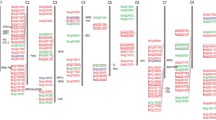Abstract
The Solanum tuberosum ankyrin repeat gene (Star) is a novel gene from potato leaves challenged by Phytophthora infestans, a pathogen causing late blight disease. The gene was isolated, based on the reported expressed sequence tag, by the rapid amplification of cDNA ends. Star contains a maximum open reading frame of 1542 bp encoding a peptide with 514 amino acids, and it encodes a RING finger ankyrin repeat protein, a putative E3 ubiquitin ligase. To the authors’ knowledge, it is the first RING finger ankyrin repeat gene isolated from the potato. The gene is highly expressed in roots, stems, and flowers at the transcript level. Star mRNA was strongly expressed from 24 to 72 h in potato leaves inoculated with P. infestans. The results suggested that Star may be involved in the development of organs and may play a role in late blight resistance.







Similar content being viewed by others
References
Borden KLB, Freemont PS (1996) The RING finger domain: a recent example of a sequence-structure family. Curr Opin Struct Biol 6:395–401
Breeden L, Nasmyth K (1987) Cell cycle control of the yeast HO gene: Cis- and Trans-acting regulators. Cell 48:389–397
Chomczynski P, Sacchi N (1987) Single step method of RNA isolation by acid guanidinium thiocyanate-phenol-chloroform extraction. Anal Biochem 162:156–159
Colon LT, Turkensteen LJ, Prummel W, Budding DJ, Hoogendoorn J (1995) Durable resistance to late blight (Phytophthora infestans) in old potato cultivars. Eur J Plant Pathol 101:387–397
Cruickshank G, Stewant HE, Wastie RL (1982) An illustrated assessment key for foliage blight of potatoes. Potato Res 25:213–214
Freemont PS (1993) The RING finger: a novel protein sequence motif related to the zinc finger. Ann N Y Acad Sci 648:174–192
Freemont PS (2000) RING for destruction? Curr Biol 10:84–87
Fry WE, Goodwin SB (1997) Resurgence of the Irish potato famine fungus. Bioscience 47:363–371
Garelik G (2002) Taking the bite out of potato blight. Science 298:1702–1704
Joazeiro CA, Weissman AM (2000) RING finger proteins: mediators of ubiquitin ligase activity. Cell 102:549–552
Michaely P, Bennett V (1992) The ANK repeat: a ubiquitous motif involved in macromolecular recognition. Trends Cell Biol 2:127–129
Nodzon LA, Xu WH, Wang Y, Pi LY, Chakrabarty PK, Song WY (2004) The ubiquitin ligase XBAT32 regulates lateral root development in Arabidopsis. Plant J 40:996–1006
Pickart CM (2001) Mechanisms underlying ubiquitination. Annu Rev Biochem 70:503–533
Song WY, Wang GL, Chen LL, Kim HS, Pi LY, Holsten T, Gardner J, Wang B, Zhai WX, Zhu LH, Fauquet C, Ronald P (1995) A receptor kinase-like protein encoded by the rice disease resistance gene Xa21. Science 270:661–667
Taylor MA, Wright F, Davies HV (1994) Characterisation of the cDNA clones of two beta-tubulin genes and their expression in the potato plant (Solanum tuberosum L.). Plant Mol Biol 26:1013–1018
Tian ZD, Liu J, Xie CH (2003) Isolation of resistance-related genes to Phytophthora infestans with suppression subtractive hybridization in the R-gene-free potato. Acta Genetica Sinica 30:597–605 (in Chinese with an English abstract)
Wang BL, Liu J, Tian ZD, Song BT, Xie CH (2005) Monitoring the expression patterns of potato genes associated with quantitative resistance to late blight during Phytophthora infestans infection using cDNA microarrays. Plant Sci 169:1155–1167
Wang YS, Pi LY, Chen XS, Chakrabarty PK, Jiang JD, DeLeon AL, Liu GZ, Li LC, Benny U, Oard J, Ronald PC, Song WY (2006) Rice XA21 binding protein 3 is a ubiquitin ligase required for full Xa21-mediated disease resistance. Plant Cell 18:3635–3646
Xu X, Jiang CZ, Donnelly L, Reid MS (2007) Functional analysis of a RING domain ankyrin repeat protein that is highly expressed during flower senescence. J Exp Bot 58:3623–3630
Yan J, Wang J, Zhang H (2002) An ankyrin repeat-containing protein plays a role in both disease resistance and antioxidation metabolism. Plant J 29:193–202
Yang JW, Song BT, Li YJ, Liu J (2006) A simple and efficient method for RNA extraction from potato tuber. J Agric Biotechnol 14:297–298 (in Chinese with an English abstract)
Acknowledgments
We thank the International Potato Center (CIP) for providing the potato clone 386209.10 with quantitative resistance to late blight. This study was supported by the National 863 Project of China (grant no. 2006AA10Z149).
Author information
Authors and Affiliations
Corresponding author
Rights and permissions
About this article
Cite this article
Wu, T., Tian, Z., Liu, J. et al. A Novel Ankyrin Repeat-rich Gene in Potato, Star, Involved in Response to Late Blight. Biochem Genet 47, 439–450 (2009). https://doi.org/10.1007/s10528-009-9238-2
Received:
Accepted:
Published:
Issue Date:
DOI: https://doi.org/10.1007/s10528-009-9238-2




